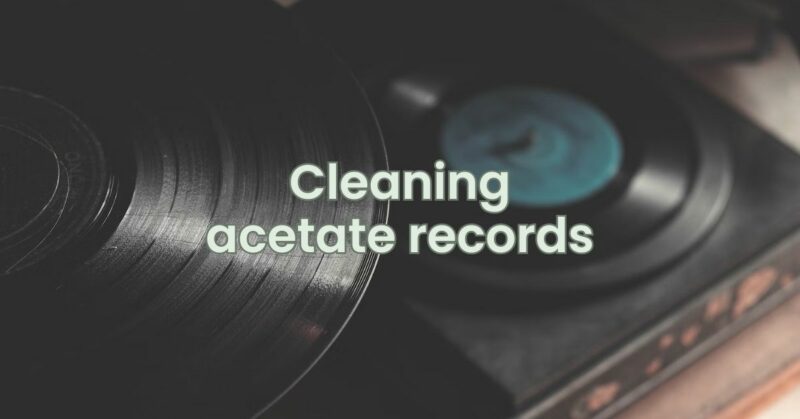Acetate records hold a special place in the history of recorded music, capturing the essence of vintage sound and cherished memories. However, due to their delicate nature and susceptibility to damage, cleaning acetate records requires careful attention and the use of appropriate cleaning techniques. In this guide, we’ll explore the characteristics of acetate records, the importance of proper cleaning, and step-by-step methods to preserve their unique charm and sound quality.
Understanding Acetate Records:
Acetate records, also known as lacquer records, were a popular medium for music recording before the widespread use of vinyl. Unlike vinyl records, which are pressed from molds, acetate records are individually cut onto a lacquer-coated aluminum disc. As a result, they are highly susceptible to damage from scratches, fingerprints, and exposure to moisture.
Why Clean Acetate Records?
Cleaning acetate records is essential for maintaining their sound quality and longevity. Over time, dirt, dust, and contaminants can accumulate on the record surface, affecting playback and causing unwanted noise, pops, and clicks. Regular cleaning not only enhances the listening experience but also preserves the record’s condition for generations to come.
Step-by-Step Guide to Cleaning Acetate Records:
- Gather Supplies:
Before starting the cleaning process, assemble the necessary supplies:
- Soft anti-static brush or carbon fiber brush
- Microfiber cleaning cloth
- Acetate-safe record cleaning solution (preferably alcohol-free and specially formulated for acetate records)
- Distilled water
- Spray bottle
- Clean, lint-free gloves (optional but recommended)
- Pre-Cleaning Inspection:
Inspect the acetate record for visible dirt, dust, fingerprints, or stains. Handle the record with clean, dry hands or wear lint-free gloves to avoid leaving fingerprints on the surface.
- Dry Brushing:
Using a soft anti-static brush or carbon fiber brush, gently remove loose dust and debris from the surface of the record. Brush in a circular motion, starting from the center and moving outward towards the edges. This step helps reduce the risk of scratching the record during the wet cleaning process.
- Wet Cleaning:
Prepare the cleaning solution by mixing a small amount of acetate-safe record cleaning solution with distilled water in a spray bottle. Follow the manufacturer’s instructions for the correct dilution ratio.
Spray the cleaning solution onto the microfiber cleaning cloth, not directly onto the record. Gently wipe the record’s surface in a circular motion, again starting from the center and moving towards the outer edges. Avoid excessive pressure and be cautious around the delicate grooves.
- Drying:
After wet cleaning, use a clean, dry section of the microfiber cleaning cloth to gently dry the record. Ensure that no excess moisture remains on the surface or within the grooves.
- Storage:
Once the acetate record is clean and dry, store it properly in a clean, acid-free inner sleeve. Keep it in an upright position in a dust-free and temperature-controlled environment.
Additional Tips for Acetate Record Care:
- Avoid using regular vinyl record cleaning solutions or alcohol-based solutions on acetate records, as they can damage the delicate surface.
- Keep acetate records away from direct sunlight, high humidity, and extreme temperatures, as these conditions can accelerate deterioration.
- If the record has significant mold or mildew growth, consult a professional audio restoration expert for specialized cleaning.
Conclusion:
Acetate records offer a nostalgic glimpse into the past, preserving vintage sound recordings that hold sentimental value for many music enthusiasts. By understanding the delicate nature of acetate records and employing proper cleaning techniques, you can enjoy their unique charm and sound quality for years to come. Regular cleaning and careful handling will not only enhance your listening experience but also safeguard these precious recordings, allowing future generations to cherish the magic of vintage sound in its purest form.

